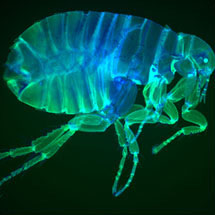 A team of scientists led by LMB’s Brad Amos has engineered a microscope with a giant lens, known as the ‘Mesolens’, that can examine thousands of cells and the detail inside each cell at the same time. The microscope has been heralded as revolutionary by scientists and could transform how researchers observe living cells in the lab.
A team of scientists led by LMB’s Brad Amos has engineered a microscope with a giant lens, known as the ‘Mesolens’, that can examine thousands of cells and the detail inside each cell at the same time. The microscope has been heralded as revolutionary by scientists and could transform how researchers observe living cells in the lab.
The microscope is now being displayed at the Royal Society’s Summer Science Exhibition, opening today at the South Bank Centre, London. Visitors are invited to take a look at ‘high definition’ fleas, mice and human brain cells as they’ve never been seen before.
The scientists developed the microscope as a response to a growing research need to examine larger and larger tissue samples, in particular early stage genetically modified mouse embryos. These 6mm embryos play a crucial step in the identification of future treatments for diseases such as cancer. Unfortunately with existing microscopes this can be a long and laborious process, however with the Mesolens, researchers can now view these embryos instantly.
Commenting on the Mesolens, Brad says: “We have worked for more than twenty years on the development of new optical systems for biomedical research. Our new microscope opens up many new possibilities for viewing large volumes of living tissue without sacrificing clarity or losing the ability to perceive depth, which has been a major problem with existing microscopes. We hope that researchers will be able to benefit from this new technology from next year.
The Royal Society Summer Science Exhibition showcases cutting edge research in science and engineering from across the UK. It is held annually at the Royal Society, the UK’s national academy of science. This year’s Festival marks the 350th Anniversary.